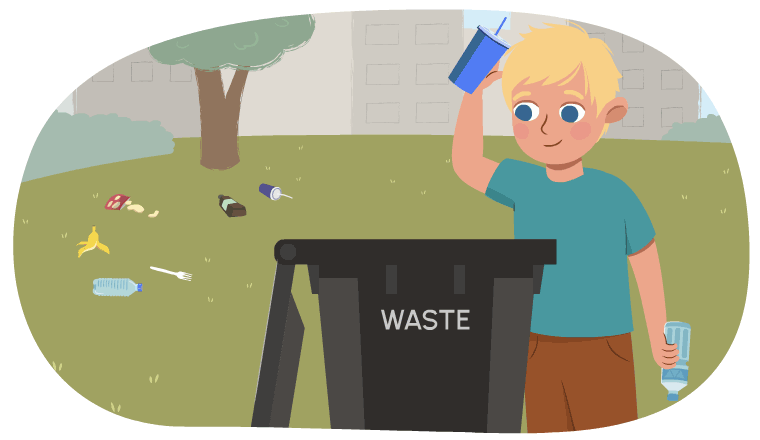Minds On
Let’s get started!
Examine the following symbols.
What do you think each symbol means?
What kinds of products might have one or more of these symbols?
Action
Part 1: Hazard symbols
In the Minds On, you examined examples of hazard symbols.

A conversation between two teachers. Teacher A asks: “What’s a hazard?” Teacher B responds, “Great question! A hazard is a material, object, or situation that could be unsafe.”
Hazard symbols are designed to warn people about materials and objects that are unsafe or need to be handled with special care.
What do the hazard symbols mean?
Let’s explore what each symbol means.
Safety information on these products is often shown in three ways:
- the hazard symbol picture
- the shape or frame that goes around the hazard symbol
- signal words that explain how unsafe a product may be (for example: caution, danger, extreme danger)
Let’s explore some hazard symbols and what they mean.
Safety information on these products is often shown in three ways:
- the picture
- the shape or frame that goes around the hazard symbol
- signal words that explain how unsafe a product may be (for example: caution, danger, extreme danger)
The picture
The picture shares the type of danger with you.
The hazard symbol frames
The shape of the frame that goes around the hazard symbol shares with you what part of the product is dangerous.
The frame will be either a triangle or an octagon.
Signal words
The signal word(s) are at the bottom of the hazard symbol. The signal word(s) describe the level of risk.
Pause and Reflect
Pause and reflect
Why do you think it’s important that the safety information is shown in three different ways (symbol, shapes, words)?
Press ‘Answer’ to explore why safety information is shown in three ways.
Using a symbol, signal words, and a shape or frame can make it easier for someone to identify and understand the possible hazard.
Let’s review your learning! For each symbol or frame, select the corresponding definition.
Part 2: Safe disposal

When we dispose of something, it means we are throwing it out.
The objects we throw out are known as waste. There are two kinds of waste. People dispose, or throw out, both non-hazardous waste and hazardous waste.
Non-hazardous waste
Non-hazardous waste is created by households, businesses, and organizations. Non-hazardous waste includes:
- paper materials
- packaging that is made of paper, plastic, glass, aluminum, and other material
- food scraps (cooked or raw)
- yard and garden waste
- tires
- cement, metals, and glass from construction and demolition sites
Hazardous waste
Hazardous waste is also created by households, businesses, and organizations.
Products that have a hazard or safety symbol are considered hazardous waste.
These products include some cleaning products, motor oil, batteries, and even oil paints!
Unlike non-hazardous waste, we have to take special care to dispose of household hazardous waste.
Disposing of hazardous waste
Hazardous liquids should never be put in the regular garbage or recycling bins, poured down the drain, into a toilet or sewer, or on the ground.
Disposing of hazardous waste in these ways can:
- harm plants and animals, including humans
- pollute wastewater and wastewater treatment systems
- leak out of the landfill and pollute ground and surface water
Press ‘Pollution’ to access a definition.
Pollution is anything that can make the earth dirty. When waste pollutes water or soil, it makes the water or soil harmful for plants and animals.
To dispose of hazardous waste safely:
- follow city or town guidelines to recycle hazardous waste.
- if possible, keep hazardous waste in its original containers.
- do not take off labels from the original containers because they have hazard symbols and list the ingredients
We can also reduce the amount of house hazardous waste that we throw out. One way to do this is by using up the product or sharing it with someone else until they use it up.
Pause and Reflect
Let's consider a scenario

Two teachers are having a conversation. Teacher A: “What if I don’t know how to dispose of a particular hazardous waste product?” Teacher B: “If you are unsure of what to do with a hazardous waste product, you can ask a trusted adult to help you contact your local waste program. Many communities offer free pick-up or have drop-off centres for hazardous waste products.” Teacher A: “That is a great tip, thank you!”
Use your learning so far to respond to the following questions:
- What might happen if someone dumps a corrosive product like bleach on the grass near a stream?
- What is a safer way of disposing of a container of bleach?
Record your ideas digitally, orally, or on paper.
Consolidation
Putting it all together

In this Learning Activity, you have learned about hazard symbols and what they mean. You have also learned about how to properly dispose, or throw out, hazardous waste.
Create a message that shares the dangers of hazardous materials and how to dispose of them properly.
You may choose to create a poster, write your message, create an audio, or video recording, or use another method of your choice.
My hazardous materials poster includes:
Record your message using a method of your choice or the My Hazardous Materials Poster document provided.
If possible, share your message with a partner or trusted adult.
|
My title: |
|
My message (use words and pictures): |
Press the ‘Activity’ button to access My Hazardous Materials Poster.
Reflection
How do you feel about what you have learned in this activity? Which of the next four sentences best matches how you are feeling about your learning? Press the button that is beside this sentence.
I feel…
Now, record your ideas about your feelings using a voice recorder, speech-to-text, or writing tool.








